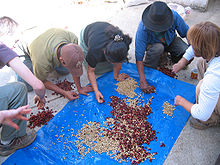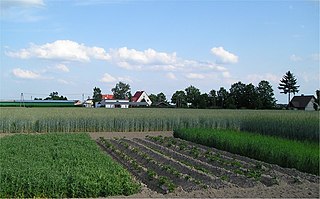
Crop rotation is the practice of growing a series of different types of crops in the same area across a sequence of growing seasons. This practice reduces the reliance of crops on one set of nutrients, pest and weed pressure, along with the probability of developing resistant pests and weeds.

In agriculture, monoculture is the practice of growing one crop species in a field at a time. Monoculture is widely used in intensive farming and in organic farming: both a 1,000-hectare cornfield and a 10-ha field of organic kale are monocultures. Monoculture of crops has allowed farmers to increase efficiency in planting, managing, and harvesting, mainly by facilitating the use of machinery in these operations, but monocultures can also increase the risk of diseases or pest outbreaks. This practice is particularly common in industrialized nations worldwide. Diversity can be added both in time, as with a crop rotation or sequence, or in space, with a polyculture or intercropping.
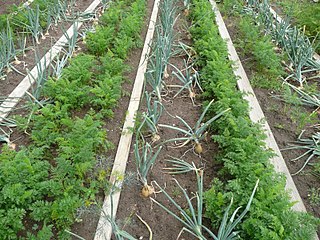
Companion planting in gardening and agriculture is the planting of different crops in proximity for any of a number of different reasons, including weed suppression, pest control, pollination, providing habitat for beneficial insects, maximizing use of space, and to otherwise increase crop productivity. Companion planting is a form of polyculture.
The following outline is provided as an overview of and topical guide to sustainable agriculture:

Intercropping is a multiple cropping practice that involves the cultivation of two or more crops simultaneously on the same field, a form of polyculture. The most common goal of intercropping is to produce a greater yield on a given piece of land by making use of resources or ecological processes that would otherwise not be utilized by a single crop.

In agriculture, polyculture is the practice of growing more than one crop species together in the same place at the same time, in contrast to monoculture, which had become the dominant approach in developed countries by 1950. Traditional examples include the intercropping of the Three Sisters, namely maize, beans, and squashes, by indigenous peoples of Central and North America, the rice-fish systems of Asia, and the complex mixed cropping systems of Nigeria.

The Three Sisters are the three main agricultural crops of various indigenous peoples of Central and North America: squash, maize ("corn"), and climbing beans. In a technique known as companion planting, the maize and beans are often planted together in mounds formed by hilling soil around the base of the plants each year; squash is typically planted between the mounds. The cornstalk serves as a trellis for climbing beans, the beans fix nitrogen in their root nodules and stabilize the maize in high winds, and the wide leaves of the squash plant shade the ground, keeping the soil moist and helping prevent the establishment of weeds.
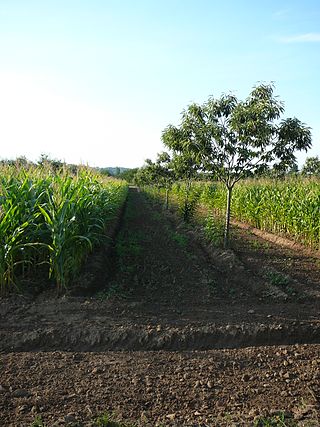
Agroforestry is a land use management system that integrates trees with crops or pasture. It combines agricultural and forestry technologies. As a polyculture system, an agroforestry system can produce timber and wood products, fruits, nuts, other edible plant products, edible mushrooms, medicinal plants, ornamental plants, animals and animal products, and other products from both domesticated and wild species.
In agriculture, monocropping is the practice of growing a single crop year after year on the same land. Maize, soybeans, and wheat are three common crops often monocropped. Monocropping is also referred to as continuous cropping, as in "continuous corn." Monocropping allows for farmers to have consistent crops throughout their entire farm. They can plant only the most profitable crop, use the same seed, pest control, machinery, and growing method on their entire farm, which may increase overall farm profitability.
Forest integrated pest management or Forest IPM is the practice of monitoring and managing pest and environmental information with pest control methods to prevent pest damage to forests and forest habitats by the most economical means.

The pink-legged graveteiro is a species of bird in the family Furnariidae that is endemic to the Atlantic Forest located in the southeast part of Brazil, thriving in local cocoa plantations. As of 2000 the pink-legged graveteiro is listed as a vulnerable species. The estimated population of the pink-legged graveteiro is between 2,500 and 9,999 individuals left in the wild. Its main habitat is cocoa plantations. It is the only member of the genus Acrobatornis.
Upland rice is a variety of rice grown on dry soil rather than flooded rice paddies.

Agroecology is an applied science that involves the adaptation of ecological concepts to the structure, performance, and management of sustainable agroecosystems. In Latin America, agroecological practices have a long history and vary between regions but share three main approaches or levels: plot scale, farm scale, and food system scale. Agroecology in Latin American countries can be used as a tool for providing both ecological, economic, and social benefits to the communities that practice it, as well as maintaining high biodiversity and providing refuges for flora and fauna in these countries. Due to its broad scope and versatility, it is often referred to as "a science, a movement, a practice."

Tephrosia vogelii, the Vogel's tephrosia, fish-poison-bean or Vogel tephrosia (English), tefrósia (Portuguese) or barbasco guineano (Spanish), is a flowering plant species in the genus Tephrosia.
Costa Rican agriculture plays a profound part in the country's gross domestic product (GDP). It makes up about 6.5% of Costa Rica's GDP, and 14% of the labor force. Depending upon location and altitude, many regions differ in agricultural crops and techniques. The main exports include: bananas, pineapples, coffee, sugar, rice, vegetables, tropical fruits, ornamental plants, corn, potatoes and palm oil.
The environmental impact of cocoa production includes deforestation, soil contamination, and herbicide resistance. The majority of cocoa farms are now located in Côte d'Ivoire and Ghana.

A rice-fish system is a polyculture practice that integrates rice agriculture with aquaculture, most commonly with freshwater fish. It is based on a mutually beneficial relationship between rice and fish in the same agroecosystem. The system was recognized by the FAO in 2002 as one of the first Globally Important Agricultural Heritage Systems.

Pekarangan is a type of tropical home garden developed in Indonesia, mainly in Java. Pekarangans typically contain plants, while some possess animals and structures such as pens and bird cages. The gardens yield food for subsistence and income, and plants for ornamental use. Along with their subsistence and commercial uses, they are used for social interactions and yield sharing and provide materials for cultural ceremonies and religious practices. Some pekarangans are made, maintained, and spatially arranged according to local values. Home gardens of this kind may have existed for several thousand years, but their first mention is found in a Javanese chronicle that was written in 860 AD. In 2010, around 103,000 square kilometers (40,000 sq mi) of Indonesian land were used for gardens of this sort.
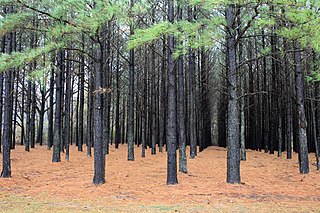
A tree plantation, forest plantation, plantation forest, timber plantation or tree farm is a forest planted for high volume production of wood, usually by planting one type of tree as a monoculture forest. The term tree farm also is used to refer to tree nurseries and Christmas tree farms.
Regenerative cacao is defined as cacao that is produced on a farm that employs regenerative agriculture and agroforestry methods. It is most closely associated with the Ecuadorian chocolate company To’ak, the organic food supplier Navitas, the rainforest conservation organization TMA, and the social-agricultural enterprise Terra Genesis. Cacao is the raw material that is used to produce chocolate.



